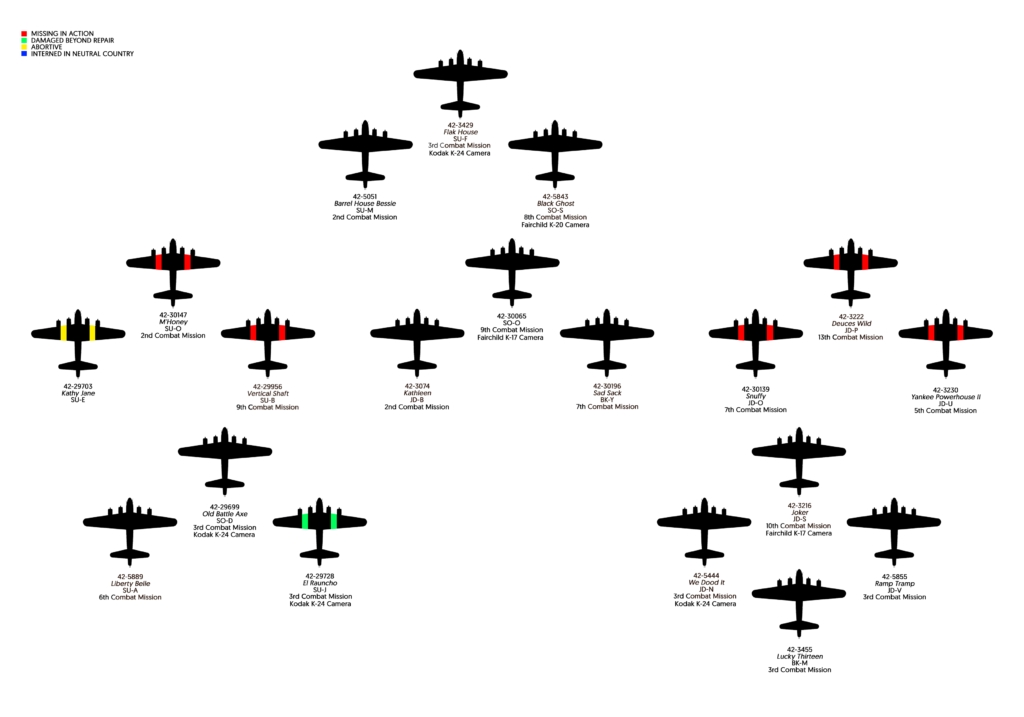77 years ago today, Lucky Thirteen flew her third combat mission.
This is going to be a long one…
17 August 1943
VIII BC No. 84
Ramrod 206
384BG No. 17
The US 8AF launches 376 Boeing B-17s, escorted by 240 Republic P-47s with 75 gal droptanks, against Regensburg and Schweinfurt, Germany. Additional escort is provided by RAF 11 Group. The operation is split into two forces:
-The 1BW, consisting of 230 aircraft led by CO 1BW COL Robert B. Williams aboard Lady Luck (42-29837, 91BG), striking the Vereinigte Kullagerfabriken (United Ball-Bearings), Kugelfischer, and Fichtel & Sachs ball-bearing plants of Schweinfurt.
-The 4BW, consisting of 146 aircraft led by CO 4BW COL Curtis E. LeMay aboard Fertile Myrtle 3rd (42-30366, 96BG), striking the Messerschmitt Flugzeugwerke of Regensburg.
Designed as a major step toward meeting the POINTBLANK Directive – i.e., air supremacy prior to D-Day – this strike is the culmination of Operation JUGGLER. JUGGLER seeks to make a crippling blow against Germany’s aviation industry by targeting three major chokepoints. Alongside the two mentioned above is the Messerschmitt plant of Wiener Neustädt, Austria, which is bombed with great success by North Africa-based Consolidated B-24s on 13 August. It is hoped that following this attack with one on Regensburg could massively impact production of the Messerschmitt Bf-109. The ball-bearing strike is another critical chokepoint, as virtually all of Germany’s supply comes from the plants of Schweinfurt.
The plan calls for the smaller force to fly on to occupied-Algeria while the second returns to England, the idea being that one force fights its way in while the second fights its way out. It is also hoped that the recent attack on Wiener Neustädt might have resulted in a shift of Germany’s fighter defense.
The operation turns to disaster when poor weather causes a delay between the two forces, allowing German fighters to rearm and refuel between interceptions. LeMay’s force had taken off despite the bad weather, knowing that any further delay would make the “shuttle” flight to Algeria impossible; Williams instead waited for the fog to clear. This also results in the majority of the US fighter groups failing to rendezvous with their wards, with almost all that do turning home before the Germans attack. This weather delay, which should have resulted in a recall, negates the sole protective aspect of JUGGLER. While the Regensburg strike is shockingly accurate and devastating, the Schweinfurt force is less fortunate, with reconnaissance photos making it clear that another operation against the ball-bearing plants would be necessary.
The 384BG launches 18 aircraft this day, the group being led by XO 384BG MAJ Thomas P. Beckett aboard Flak House (42-3429). Lucky Thirteen flies “Tail End Charlie” as the fourth aircraft in the low squadron’s second element.
The numbers:
| Bombers Launched: | 376 |
| Bombers Effective: | 315 |
| Fighters Launched: | 240 |
| Bombers MIA: | 60 |
| Bombers DBR: | 4 |
| Bombers Abort: | 61 |
| Fighters MIA: | 3 |
| Abort Rate: | 16% |
| Loss Rate: | 17% |
| E/A Destroyed: | 51 |
*Please note that the numbers above come from official US and German sources as victory claims cannot be relied upon. The numbers above do not account for RAF statistics.
RAF 11 Group loses two Supermarine Spitfires in today’s escort operations.
Lucky Thirteen flies with a different crew this day, carrying men normally assigned to Battle Wagon (42-30026, 384BG). She does not escape unharmed. A 20mm autocannon shell explodes in the waist compartment, wounding waist gunners SSGT John F. Schimenek and SSGT L. Corwin Miller. While Miller’s lung is punctured, he holds his position until a break in fighter attacks allows radio operator TSGT Francis Gerow to administer first aid. Miller is awarded the Silver Star and Purple Heart for his actions, but Schimenek does not receive his Purple Heart until 1993 when comrades petition on his behalf.
Lucky Thirteen is officially credited with an aerial victory, with tail gunner SSGT Casmer R. Majewski claiming an FW-190 over Antwerp.
Lucky Thirteen is one of seven 384BG aircraft pulled off the line for major repair following Operation JUGGLER.
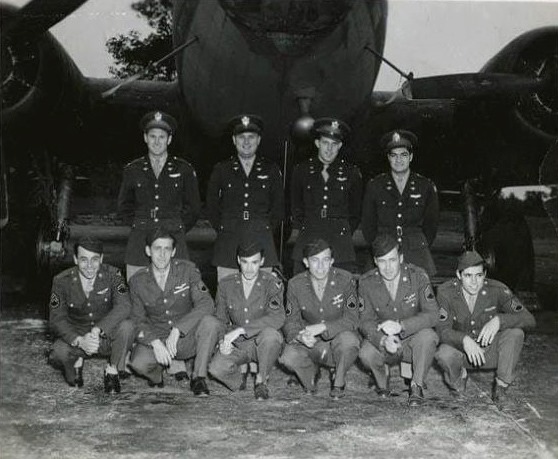
The crew of Battle Wagon (42-30026, 384BG) – the crew who mans Lucky Thirteen over Schweinfurt.
Back Row (left to right):
CPT James C. McClanahan (Bombardier)
CPT Phillip M. Algar (Pilot)
1LT Richard V. Wolf (Pilot)
CPT Frank A. Celentano (Navigator)
Front Row (left to right)
SSGT John F. Schimenek (Gunner)
SSGT Casmer R. Majewski (Gunner)
SSGT Roland B. Laviolette (Engineer)
SSGT L. Corwin Miller (Gunner)
TSGT Francis Gerow (Radio Operator)
SSGT Kenneth M. McKay, Jr. (Gunner)
This crew completes their tour-of-duty on 3 March 1944, being recalled from what would have been the first US strike on Berlin.
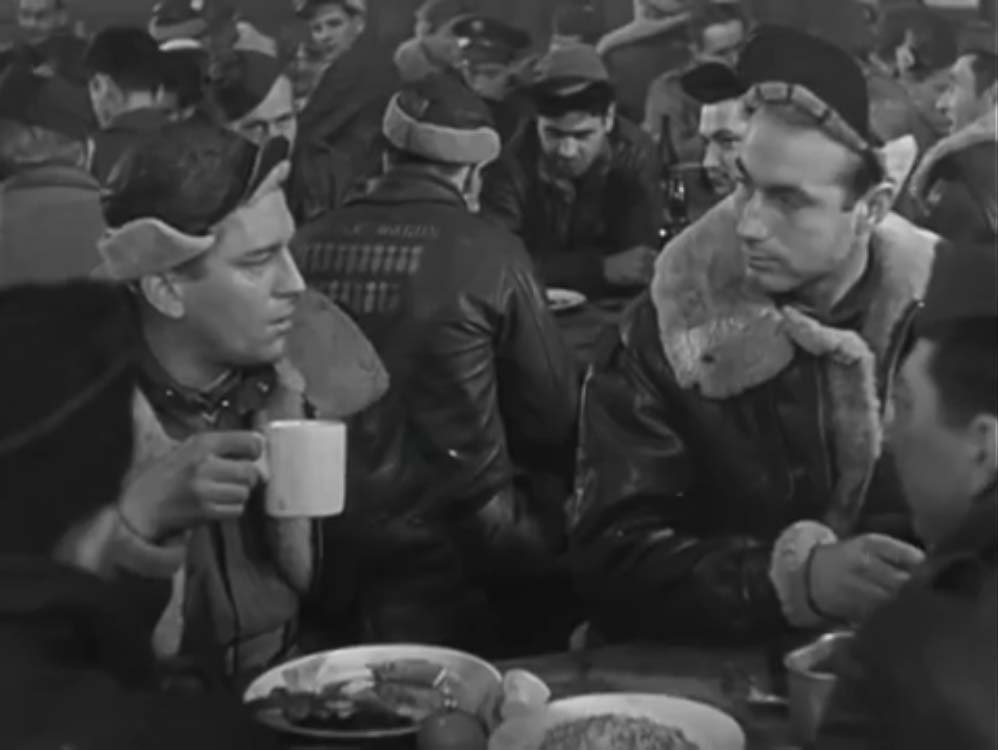
SSGT Casmer R. Majewski appears in the documentary Target For Today roughly around the 29:40 minute mark. During this scene, SSGT John F. Schimenek can be seen behind Majewski eating an orange.
Majewski teases the others by referring to the “two Jerries I slapped down over Schweinfurt,” though records only confirm a single kill by Majewski that day.
Target for Today was an attempt by the Army to break down the operations of a typical US 8AF strike. The film follows the planning and execution of the 9 October 1943 bombing of Anklam, Malbork, and Gdansk, Germany and Gdynia, Poland.
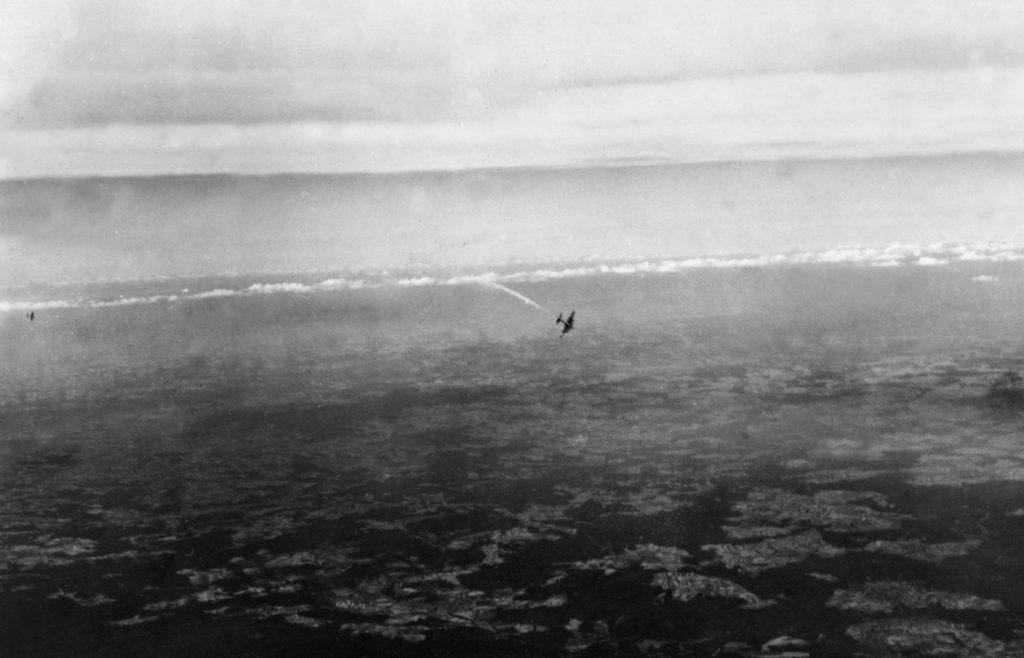
One of the iconic images of the air war over Europe – a unidentified B-17F is shot down during Operation JUGGLER.
The fighter that claimed it is visible nearby.
This photo was taken by SSGT John F. Schimenek from the left waist position on Lucky Thirteen.
The 384BG’s formation chart from this day.
Kathy Jane aborts due to a bad starter on her No. 1 engine.
Two others also abort: Kathleen (42-3074) and Old Battle Axe (42-29699). The former suffers a failure of her No. 2 engine and the latter on engines No. 1 and No. 3. These two are not noted on the chart as they are nevertheless given credit for this day’s mission.
Five aircraft of the 384BG – M’Honey (42-30147), Vertical Shaft (42-29956), Snuffy (42-30139), Deuces Wild (42-3222), and Yankee Powerhouse II (42-3230) – are lost this day. All are shot down en route to the target.

Ray’s uncle, MSGT Marvin Hudson (wearing sunglasses), supervises repairs to Lucky Thirteen.
This is the only photo of Lucky Thirteen that we have yet located. While the aircraft in the photo has not been positively identified, based on the evidence, we believe this is her.
Six aircraft of the 384BG are pulled from the line for repairs following Operation JUGGLER. They are: Joker (42-3216), Liberty Belle (42-5889), “O for Oscar” (42-30065), Flak House (42-3429), Barrel House Bessie (42-5051), and Lucky Thirteen (42-3455). A seventh, El Rauncho (42-29728) is damaged beyond repair and written off.
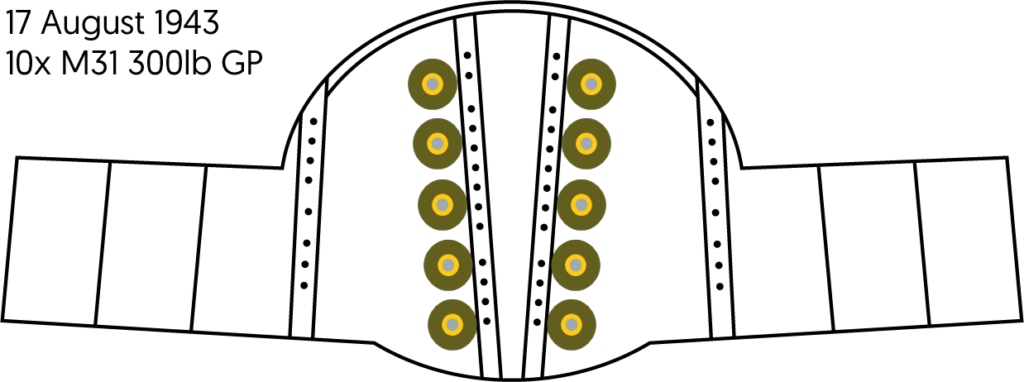
Lucky Thirteen‘s bombload for 17 August 1943.
While the Boeing B-17 was capable of carrying sixteen M31 300 lb bombs internally, note how this loadout only carries ten. This is to maximize range by decreasing the aircraft’s weight. Roughly 575 miles away, the attack on Schweinfurt was the deepest penetration of the US 8AF in the war thus far.
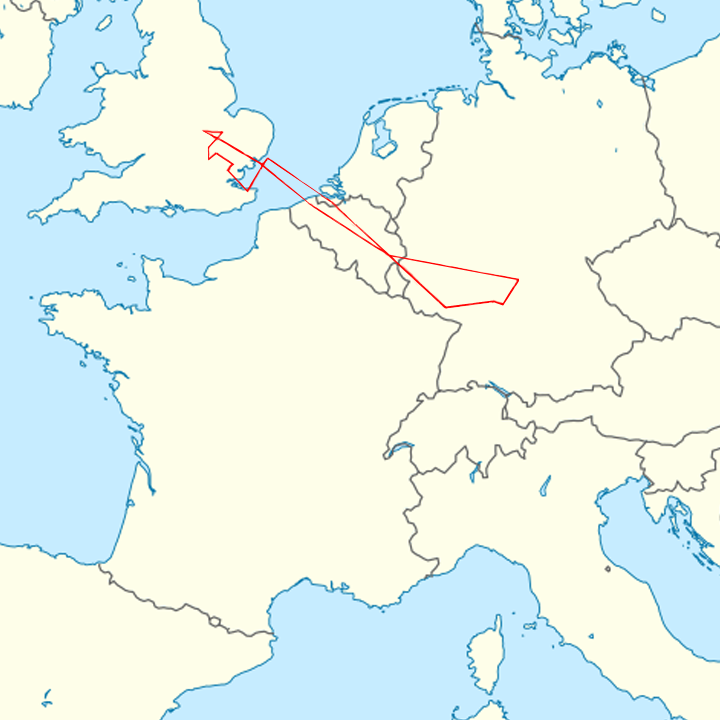
The 384BG’s strike route for 17 August 1943. The target was bombed from an altitude of 20,000 ft. Average temperature was -12 degrees.
| Taxi: | 11:20 |
| Takeoff: | 11:40 |
| Target I: | 3:07 |
| Home: | 6:06 |
The plan had called for the two forces to come in together, but in order for the Regensburg force to make the flight to Algeria, they had to be airborne between 6:30 and 8 am. Realizing that he could not wait any longer, CO 4BW COL Curtis E. LeMay – who had insisted his pilots be trained in instrument takeoffs – launched his attack far ahead of the 1BW, which did not takeoff until almost noon.

Schweinfurt as it appears today. The ball-bearing plants are all on the north side of town near the banks of the Main River. In fact, smoke can be seen rising from one of these facilities.
This photo was taken facing north. The attack of 17 August 1943 was made at 95 degrees, which roughly translates as left to right with a slight downward slant.
Of the 16 strikes against Schweinfurt, the one of 14 October 1943 inflicts the most damage, cutting production by some 75%. However, the inability to consistently strike the plants in light of heavy losses allows RBM B. K. H. Albert Speer to disperse the industry between attacks, importing bearings from neutral Sweden. Speer had recognized the dangers ball-bearing strikes posed and began this process almost immediately after Schweinfurt I (17 August 1943). Some of the blame for this rests with CINC RAF BC Air Mshl Sir Arthur T. Harris, who steadfastly denied ordering followup strikes against US targets.
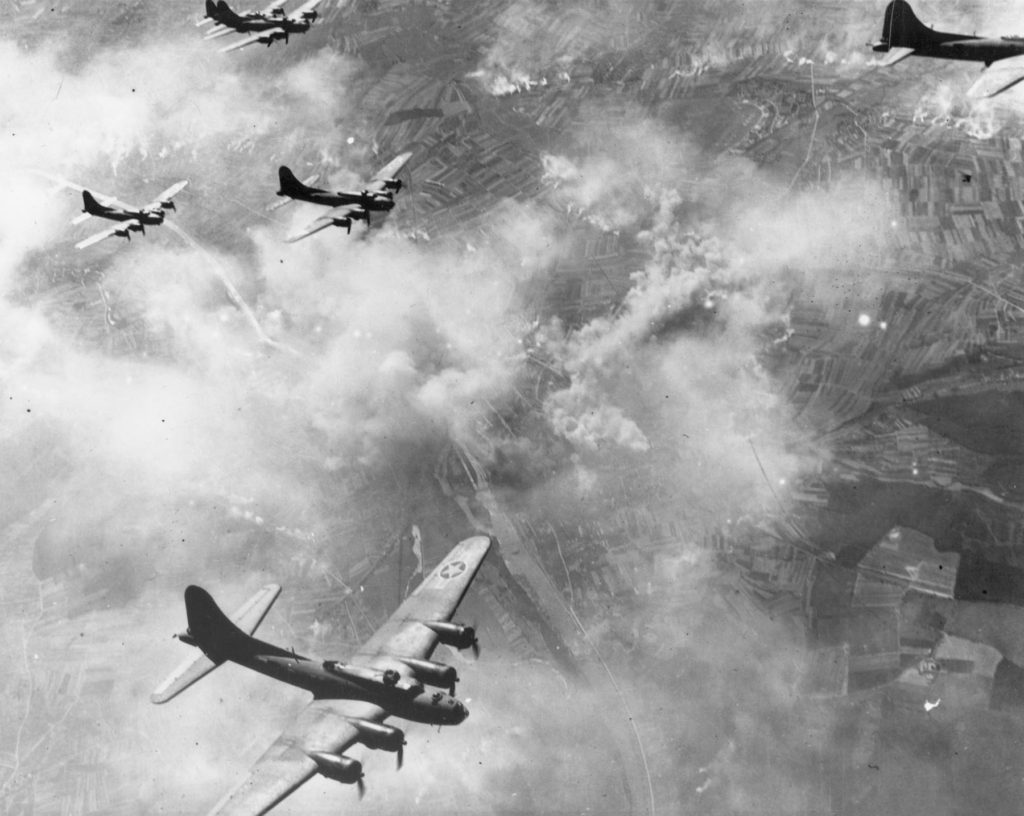
Boeing B-17Fs of the 1BW over Schweinfurt. Note the river Main below.

The main offices of the Fichtel & Sachs ball bearing plant of Schweinfurt, as seen in 1930.
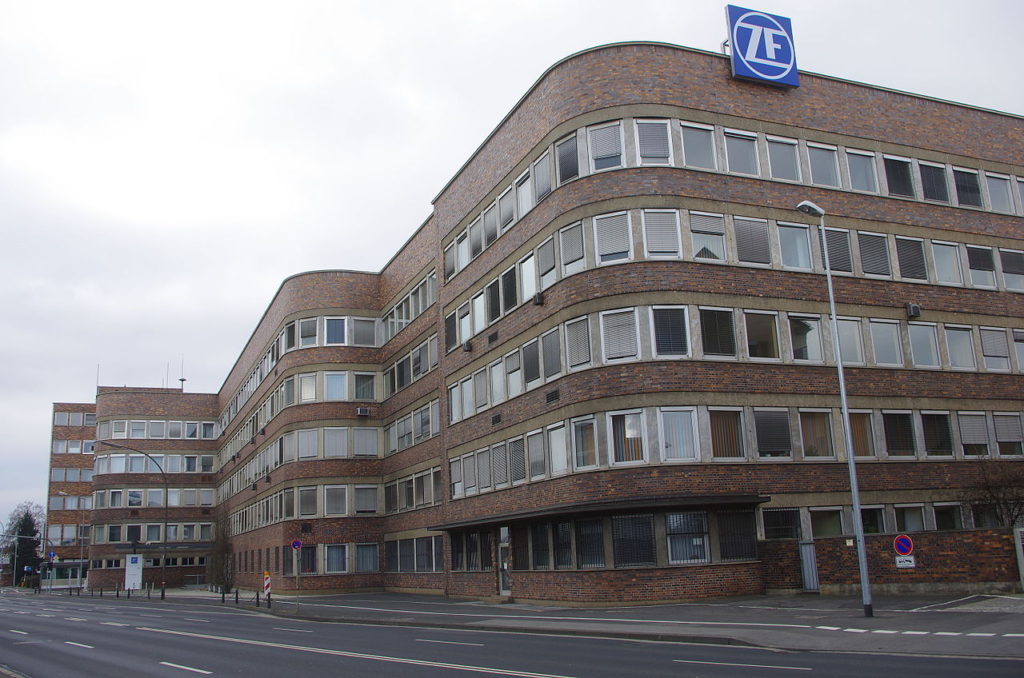
The main offices of the Fichtel & Sachs ball bearing plant of Schweinfurt today.
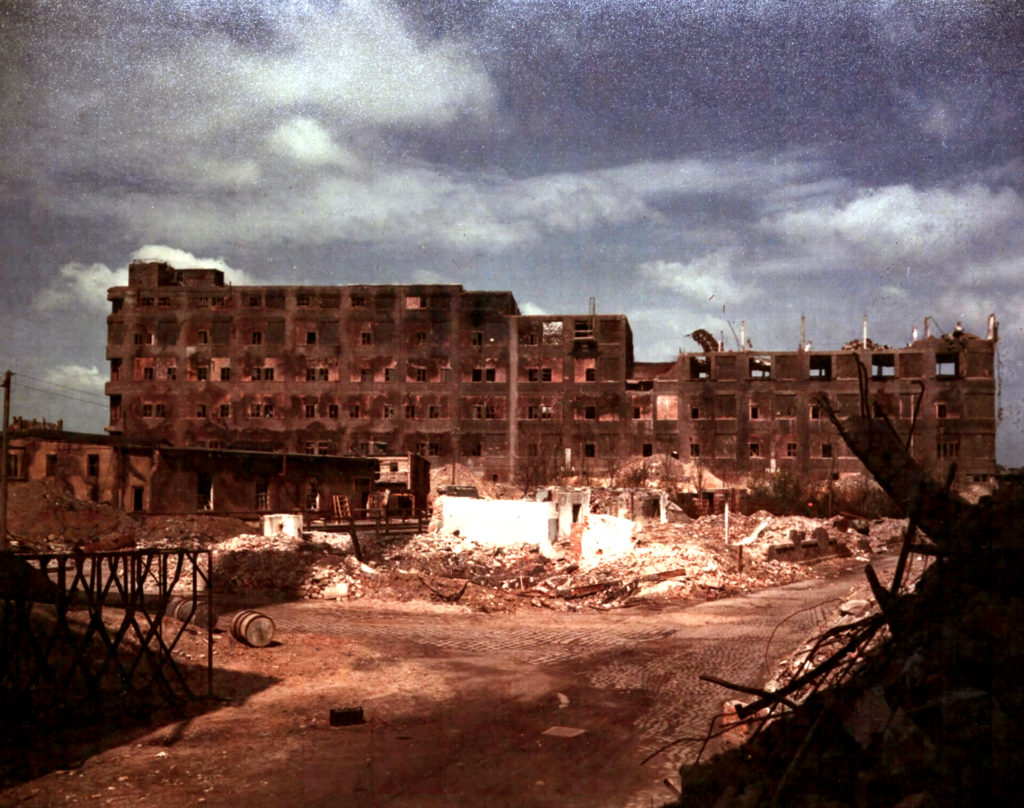
The ruins of Schweinfurt as photographed by US Army inspection teams after the war.

